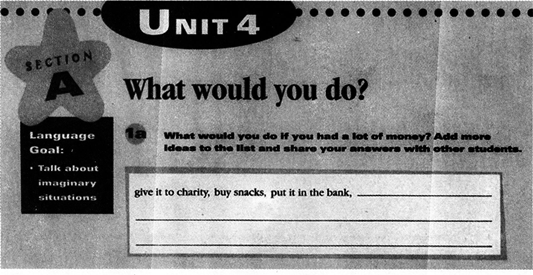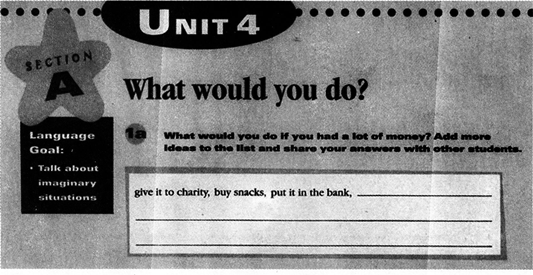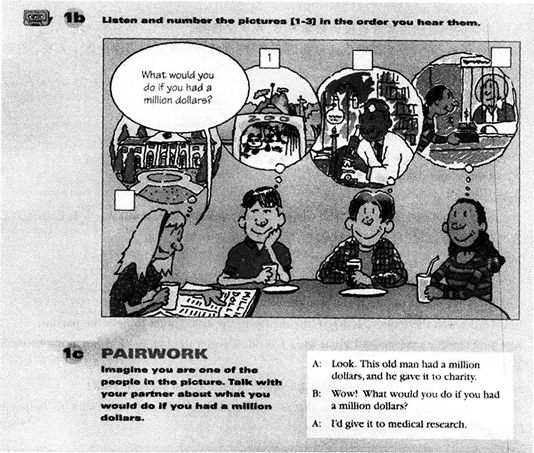Betty: What a foolish thing I've done! I broke my watch.Rose: It's really unfortunate.______. There must be some ways to make up for it.
题目
Betty: What a foolish thing I've done! I broke my watch.
Rose: It's really unfortunate.______. There must be some ways to make up for it.
相似考题
更多“Betty: What a foolish thing I've done! I broke my watch. Rose: It's really unfortuna ”相关问题
-
第1题:
Susan: Betty, we'd like you to join us at a buffet party next Saturday.
Betty: ___________, Susan. What time do you expect me to be there?
A、I'd love to
B、No way
C、By no means
D、I'm afraid not
参考答案:A
-
第2题:
根据提供的信息和语言素材设计教学方案,用英文作答。
设计任务:请阅读下面学生信息和语言素材。设计一节英语口语课的教学方案。教案没有固定格式,但须包含下列要点:
·teaching ;objectives
·teaching ;contents
·key ;and ;difficult ;broints
·major ;stebrs ;and ;time ;allocation
· ;activities ;and ;justifications
教学时间:45分钟
学生概况:某城镇普通中学九年级(初中三年级)学生,班级人数40人,多数已经达到《义务教育英语课程标准(2011版)》四级水平,学生课堂参与积极性一般。
语言素材:
;Boy ;1: ;Wow, ;how ;luck!
;Girl ;1 ;: ;What ;would ;you ;do ;if ;you ;won ;the ;lottery
;Boy ;1 ;: ;If ;I ;won ;the ;lottery, ;I'd ;give ;the ;money ;to ;the ;Zoo. ;I ;want ;to ;helbr ;the ;brandas.
;Girl ;1 ;.. ;That's ;a ;good ;idea ;! ;I ;know ;what ;I' ;d ;do. ;If ;I ;won ;the ;lottery, ;I' ;d ;buy ;a ;big ;house ;for ;my ;family.
;Girl ;2.. ;Really ;I'd ;brut ;the ;money ;in ;the ;bank. ;Then ;I'd ;just ;watch ;it ;grow!
;Boy ;2: ;Hmm ;... ;I ;think ;I'd ;give ;the ;money ;to ;medical ;research. ;I'd ;want ;to ;helbr ;other ;breobrle.
 答案:解析:Teaching Contents: In this class, students could control the structure"I would / I'd do" to talk about the imaginary situations. Teaching Objectives ..
答案:解析:Teaching Contents: In this class, students could control the structure"I would / I'd do" to talk about the imaginary situations. Teaching Objectives ..
( 1 ) Knowledge objective
①Key Vocabulary
lottery, million, medical, research
②Target Language
Look!This girl won a million dollars in the lottery.
Wow! What would you do if you won a million dollars
I'd give it to medical research.
③ Structure
I would / I'd do
(2) Ability objective
Students' listening ability will be well improved.
(3) Emotional objective
Students can be more interested in English. Students should remember it's really being cool to realize your dream through great efforts.
Teaching Key Points:
(1) Target language
(2) The structure: I would / I'd do
Teaching Difficult Point:
The structure : I would / I' d do
Teaching Aid :
A tape recorder
Teaching Procedures:
Step 1 Revision (3 minutes)
Review the structure "should be allowed to" by asking students to make sentences about school rules.
(Justification: The revision can examine students' learning effect and easily lead in the text.)
Step 2 Presentation (25 minutes)
la
This activity focuses on vocabulary and structures introduced in the unit.
Read the instructions to the class.
Call students' attention to the words in the box. Ask a student to read them to the class.
T: What would you do if you had a lot of money Add more ideas to the list.
Then share your answers with other students.
Get students to complete the task. First individually, then in groups.
As they work, walk around the room checking progress and offering any help they may need.
Collect answers from students on the blackboard.
Answers will vary but should include a mixture of ideas for helping themselves and others.
1b
The teacher reads the instructions to the class, and reads the question in the speech bubble, then explains the word "lottery" to students.
T: You will hear teenagers talking about what they would do if they won the lottery.
Point to the pictures. Ask students to describe them one by one.
For example, for Picture One, a student might say, "If I won the lottery, I' d buy a big house."
Point out the sample answer.
T: The first picture you will hear about has the number one on it.
Play the recording for the first time. Students only listen.
Play the recording again. This time students listen and number the pictures in the order they hear them.
Check the answers.
(Justification: This step can arouse students' interests and presents the target language in spoken conversation.)
Step 3 Practice (12 minutes)
Read the instructions to the class in order to call students' attention to the conversation in the box. Then,explain the vocabulary words"million" and"medical research". Finally, invite a pair of students to read it to the class.
S1 : Look ! This girl won a million dollars in the lottery.
S2: Wow! What would you do if you won a million dollars
S1 : I'd give it to medical research.
Write it on the blackboard.
T: Pretend you are the people in the picture. Talk with your partner about what you would do if you won a million dollars.
Get students to work in pairs. As they work in pairs together, walk around the room offering language support as needed.
After students have had a chance to practice several exchanges, ask pairs to come to the front of the classroom and act out their conversations.
(Justification: This step can provide an oral practice using the target language for students.)
Step 4 Summary and Homework (5 minutes)
Summary: In this class, we've learned some vocabulary words and the target language"What would you do if you won the lottery I'd give it to medical research".
Homework: If you had a large amount of money, e.g. $100,000, what would you buy Please write down each item and its cost to see how you will spend the full amount. And bring your lists to class tomorrow.
(Justification: Homework can help students consolidate what they have learned in this class and improve their writing abilities.)
Blackboard Design :
Unit 4 What would you do
Section A
The First Period
Target language :
A: Look. This girl won a million dollars in the lottery.
B: Wow! What would you do if you won a million dollars
A: I'd give it to medical research. -
第3题:
根据题目要求完成下列任务,用中文作答。
以下是某堂课老师的教学材料:
?Betty: Hi Mum, can you hear me?
?Mum: Yes, I can. Where are you?
?Betty : I' m standing on the Great Wall of China and talking to you.
?Mum: Really?
?Betty: We're on a school trip and we've having lunch. And we're lying in the sun and we' re taking lots of photos.
?Mum: That's great, Betty. What are the others doing?
Betty: Well, Tony is eating an ice cream, and Lucy is buying some presents and postcards.
And Tom is eating lunch and lying in the sun.
Mum: Can you send me a post card?
Betty: Yes. Lucy and I are writing postcards. We're enjoying the school trip a lot. Anyway,
we're going home now. Bye!
Mum: Bye bye, Betty!
任务要求:根据材料内容回答以下三个问题。
(1)这份材料属于哪种语篇类型?(7分)
?(2)这份材料适合于哪种课堂教学?说明理由(至少写出两个要点)。(8分)
(3)分析教师选用文本材料时需要考虑的基本要素(至少写出三个要点)。(15分)答案:解析:(1)语篇指的是实际使用的语言单位,是一次交际过程中的一系列连续的话段或句子所构成的语言整体。 根据韩礼德的观点,语篇是一个语义单位或意义潜势的现实化,任何一个口头或书面语言片段。不论其长短,只要能构成一个语义整体,即表达完整的意思,就可以称之为语篇。根据语篇的概念,该材料属于会话语篇。
(2)这份材料适合于口语教学。
理由:
①材料语言比较简单,没有生僻词汇,句式偏向口语化,适合用于口语练习;
②选材偏向生活化,有生活气息.适合平时与人交际使用,英语口语的最终目的就是让学生达到沟通交流,因此会话语篇可以提供这样一个交流的环境。
⑧材料以对话形式呈现有问有答,也有连读和吞音部分,对于语音语调的学习都是很好的内容。
(3)考虑要素:
①教学内容要素:教学内容是要完成的教学任务,是实现教学目标的主要载体。因此教师在选择材料时,将教科书作为主要依据,教材分析基本关注教学的重点、难点及考点方面。比较注重显性教材的运用而忽视隐性教材的挖掘和利用,较少关注与学习教材内容有密切关系的认知和心理因素。以及教材对学生能力的要求,而对教学的重点和难点也只是阐述其内容,没有做进一步的分析。在新课改背景下,教学内容分析既要求对显性教材的运用,也要求对隐性教材的挖掘和利用。
②教学对象要素:学生是分析教学任务必须要考虑的因素。分析学生是为了帮助学生解决学习中的困难,完成教学任务。教师应该做到以下两点:一是要了解教学活动开始前学生在认知、情感、态度等方面已经达到了什么样的水平,这一水平标志着学生已经能做什么,说什么,想明白了什么等等(即学生的学历和学情)。这是学生掌握新的学习任务的起点水平。二是要了解教授了教学材料后预期学生在认知、情感、态度等方面必须达到的状态。对这种状态的把握最终会转化为确定的教学任务与具体的学习目标。只有当教师的心中对教学前和教学后这两种状态的差距做到心中有数时,才能根据学生的实际情况,确定恰当的教学内容。
③教学目标要素:教学目标是教育者在教学过程中,希望受教育者达到的要求或产生的变化结果,也是教师完成教学任务的归宿。新课程标准从关注学生的学习出发,强调学生是学习的主体,教学目标是教学活动中师生共同追求的,而不是由教师所操纵的。因此,教学目标的主体显然应该是学生。教师在选择教学材料的同时也要以学生为出发点,思考需要完成怎样的教学目标或达到怎样的教学效果。 -
第4题:
根据提供的信息和语言素材设计教学方案,用英文作答。?
设计任务:请阅读下面学生信息和语言素材。设计一节英语口语课的教学方案。教案没有固定格式,但须包含下列要点:?
·teaching ;objectives?
·teaching ;contents?
·key ;and ;difficult ;broints?
·major ;stebrs ;and ;time ;allocation?
· ;activities ;and ;justifications?
教学时间:45分钟?
学生概况:某城镇普通中学九年级(初中三年级)学生,班级人数40人,多数已经达到《义务教育英语课程标准(2011版)》四级水平,学生课堂参与积极性一般。?
语言素材:?
;Boy ;1: ;Wow, ;how ;luck!?
;Girl ;1 ;: ;What ;would ;you ;do ;if ;you ;won ;the ;lottery??
;Boy ;1 ;: ;If ;I ;won ;the ;lottery, ;I'd ;give ;the ;money ;to ;the ;Zoo. ;I ;want ;to ;helbr ;the ;brandas.?
;Girl ;1 ;.. ;That's ;a ;good ;idea ;! ;I ;know ;what ;I' ;d ;do. ;If ;I ;won ;the ;lottery, ;I' ;d ;buy ;a ;big ;house ;for ;my ;family.?
;Girl ;2.. ;Really? ;I'd ;brut ;the ;money ;in ;the ;bank. ;Then ;I'd ;just ;watch ;it ;grow!?
;Boy ;2: ;Hmm ;... ;I ;think ;I'd ;give ;the ;money ;to ;medical ;research. ;I'd ;want ;to ;helbr ;other ;breobrle.?
 答案:解析:Teaching Contents: In this class, students could control the structure"I would / I'd do" to talk about the imaginary situations. Teaching Objectives ..
答案:解析:Teaching Contents: In this class, students could control the structure"I would / I'd do" to talk about the imaginary situations. Teaching Objectives ..
?( 1 ) Knowledge objective
①Key Vocabulary
lottery, million, medical, research
②Target Language
Look!This girl won a million dollars in the lottery.
Wow! What would you do if you won a million dollars?
I'd give it to medical research.
③ Structure
I would / I'd do
?(2) Ability objective
Students' listening ability will be well improved.
(3) Emotional objective
Students can be more interested in English. Students should remember it's really being cool to realize your dream through great efforts.
Teaching Key Points:
(1) Target language
(2) The structure: I would / I'd do
Teaching Difficult Point:
The structure : I would / I' d do
Teaching Aid :
A tape recorder
Teaching Procedures:
Step 1 Revision (3 minutes)
Review the structure "should be allowed to" by asking students to make sentences about school rules.
(Justification: The revision can examine students' learning effect and easily lead in the text.)
Step 2 Presentation (25 minutes)
la
This activity focuses on vocabulary and structures introduced in the unit.
Read the instructions to the class.
Call students' attention to the words in the box. Ask a student to read them to the class.
T: What would you do if you had a lot of money?Add more ideas to the list.
Then share your answers with other students.
Get students to complete the task. First individually, then in groups.
As they work, walk around the room checking progress and offering any help they may need.
Collect answers from students on the blackboard.
Answers will vary but should include a mixture of ideas for helping themselves and others.
1b
The teacher reads the instructions to the class, and reads the question in the speech bubble, then explains the word "lottery" to students.
T: You will hear teenagers talking about what they would do if they won the lottery.
Point to the pictures. Ask students to describe them one by one.
For example, for Picture One, a student might say, "If I won the lottery, I' d buy a big house."
Point out the sample answer.
T: The first picture you will hear about has the number one on it.
Play the recording for the first time. Students only listen.
Play the recording again. This time students listen and number the pictures in the order they hear them.
Check the answers.
?(Justification: This step can arouse students' interests and presents the target language in spoken conversation.)
Step 3 Practice (12 minutes)
Read the instructions to the class in order to call students' attention to the conversation in the box. Then,explain the vocabulary words"million" and"medical research". Finally, invite a pair of students to read it to the class.
?S1 : Look ! This girl won a million dollars in the lottery.
?S2: Wow! What would you do if you won a million dollars?
?S1 : I'd give it to medical research.
?Write it on the blackboard.
?T: Pretend you are the people in the picture. Talk with your partner about what you would do if you won a million dollars.
Get students to work in pairs. As they work in pairs together, walk around the room offering language support as needed.
After students have had a chance to practice several exchanges, ask pairs to come to the front of the classroom and act out their conversations.
(Justification: This step can provide an oral practice using the target language for students.)
Step 4 Summary and Homework (5 minutes)
Summary: In this class, we've learned some vocabulary words and the target language"What would you do if you won the lottery?I'd give it to medical research".
Homework: If you had a large amount of money, e.g. $100,000, what would you buy?Please write down each item and its cost to see how you will spend the full amount. And bring your lists to class tomorrow.
(Justification: Homework can help students consolidate what they have learned in this class and improve their writing abilities.)
Blackboard Design :
Unit 4 What would you do?
Section A
The First Period
Target language :
A: Look. This girl won a million dollars in the lottery.
B: Wow! What would you do if you won a million dollars?
A: I'd give it to medical research. -
第5题:
根据题目要求完成下列任务,用中文作答。
以下是某堂课的教学材料:?
Betty: Hi Mum, can you hear me?
Mum: Yes, I can. Where are you?
Betty: I'm standing on the Great Wall of China and talking to you.
Mum: Really?
Betty: We're on a school trip and we've having lunch. And we're lying in the sun and we'retaking lots of photos.
Mum: That's great, Betty. What are the others doing?
Betty: Well, Tony is eating an ice cream, and Lucy is buying some presents and postcards.And Tom is eating lunch and lying in the sun.
Mum: Can you send me a post card?
Betty: Yes. Lucy and I are writing postcards. We're enjoying the school trip a lot. Anyway,we're going home now. Bye!
Mum: Bye bye, Betty!
根据材料内容回答以下三个问题。
(1)这份材料属于哪种语篇类型?(7分)
(2)这份材料适合于哪种课堂教学?说明理由(至少写出两个要点)。(8分)
(3)分析教师选用文本材料时需要考虑的基本要素(至少写出三个要点)。(15分)答案:解析:(1)语篇指的是实际使用的语言单位,是一次交际过程中的一系列连续的话段或句子所构成的语言整体。
根据韩礼德的观点,语篇是一个语义单位或意义潜势的现实化,任何一个Ll头或书面语言片段,不论其长短,只要能构成一个语义整体,即表达完整的意思,就可以称之为语篇。根据语篇的概念,该材料属于会话语篇。
(2)这份材料适合于口语教学。
理由:
①材料语言比较简单,没有生僻词汇,句式偏向口语化,适合用于口语练习;
②选材偏向生活化,有生活气息,适合平时与人交际使用,英语口语的最终目的就是让学生达到沟通交流,因此会话语篇可以提供一个交流的环境。
③材料以对话形式呈现有问有答,也有连读和吞音部分,对于语音语调的学习都是很好的内容。
(3)考虑要素:
①教学内容要素:教学内容是要完成的教学任务,是实现教学目标的主要载体。因此教师在选择材料时,将教科书作为主要依据,教材分析基本关注教学的重点、难点及考点方面,比较注重显性教材的运用而忽视隐性教材的挖掘和利用,较少关注与学习教材内容有密切关系的认知和心理因素,以及教材对学生能力的要求,而对教学的重点和难点也只是阐述其内容,没有做进一步的分析。在新课改背景下,教学内容分析既要求对显性教材的运用,也要求对隐性教材的挖掘和利用。
②教学对象要素:学生是分析教学任务必须要考虑的因素,分析学生是为了帮助学生解决学习中的困难,完成教学任务。教师应该做到以下两点:一是要了解教学活动开始前学生在认知、情感、态度等方面已经达到了什么样的水平,这一水平标志着学生已经能做什么,说什么,想明白了什么等(即学生的学历和学情)。这是学生掌握新的学习任务的起点水平。二是要了解教授了教学材料后预期学生在认知、情感、态度等方面必须达到的状态。对这种状态的把握最终会转化为确定的教学任务与具体的学习目标。只有当教师对教学前和教学后这两种状态的差距做到心中有数时.才能根据学生的实际情况.确定恰当的教学内容。
③教学目标要素:教学目标是教育者在教学过程中,希望受教育者达到的要求或产生的变化结果,也是教师完成教学任务的归宿。新课程标准从关注学生的学习出发,强调学生是学习的主体,教学目标是教学活动中师生共同追求的,而不是由教师所操纵的。因此,教学目标的主体显然应该是学生。教师在选择教学材料的同时也要以学生为出发点,思考需要完成怎样的教学目标或达到怎样的教学效果。
